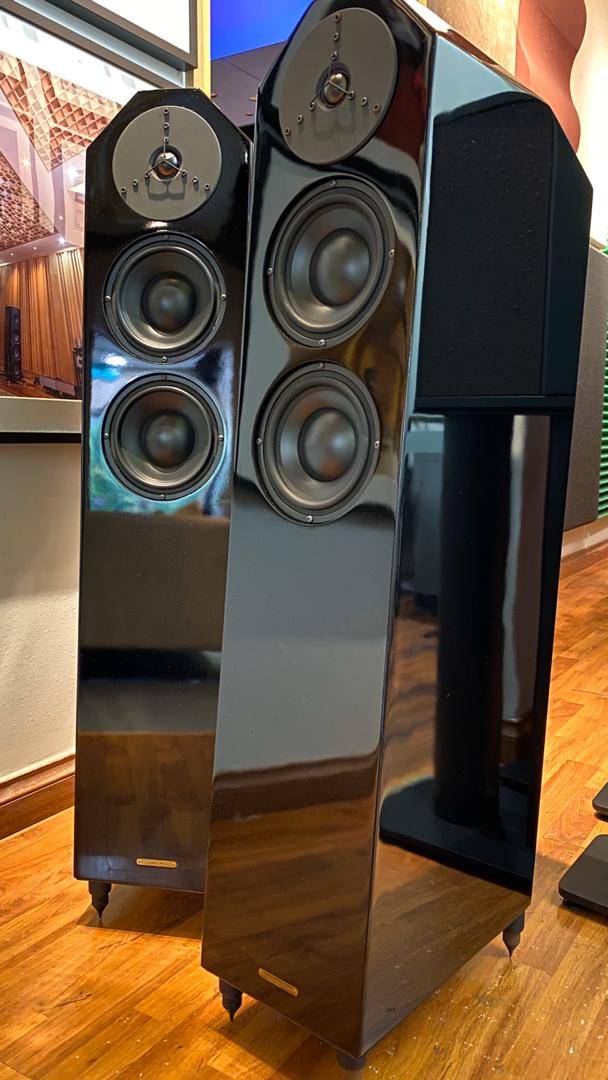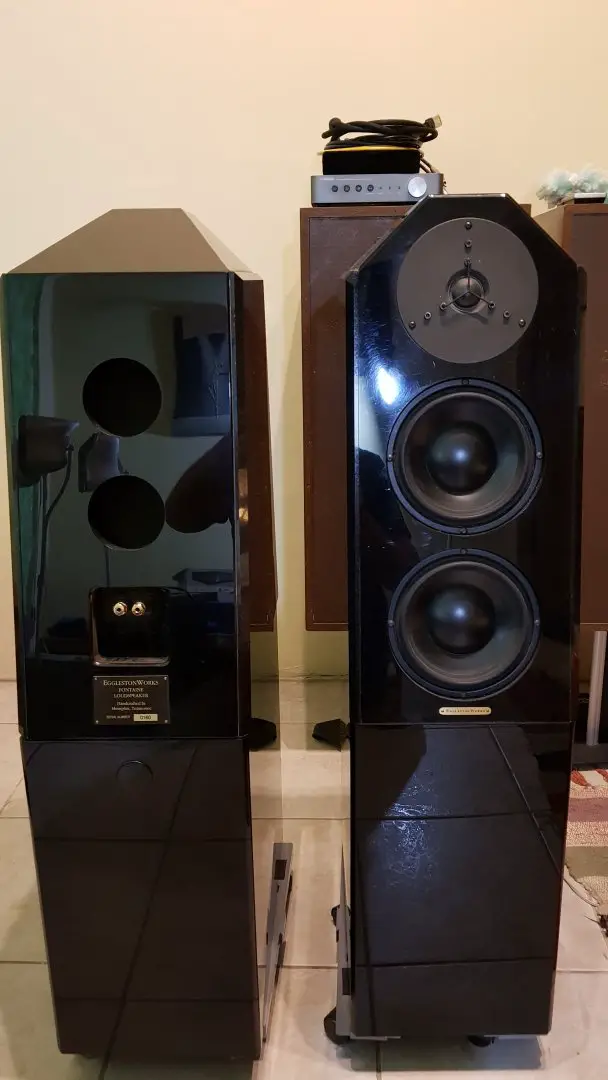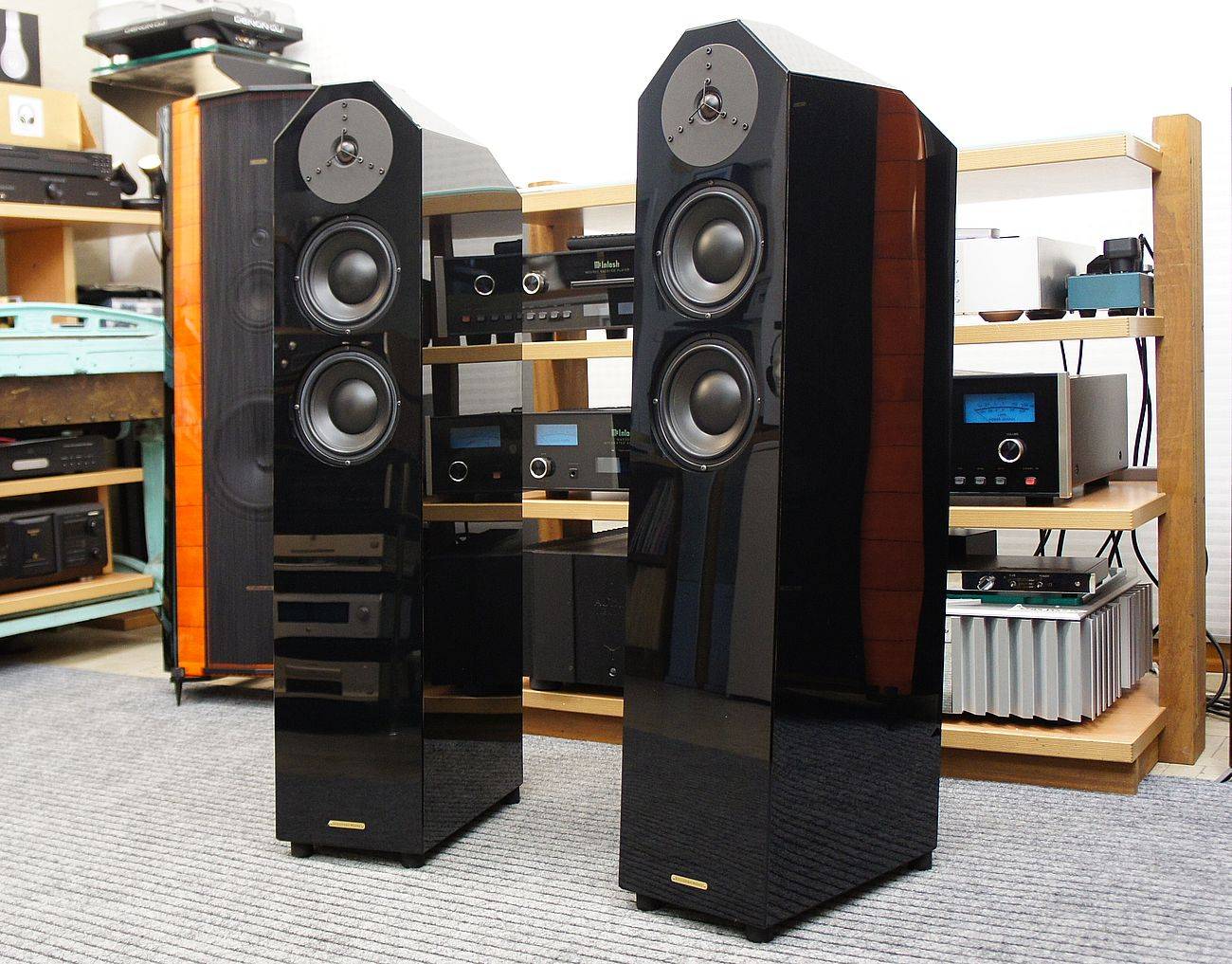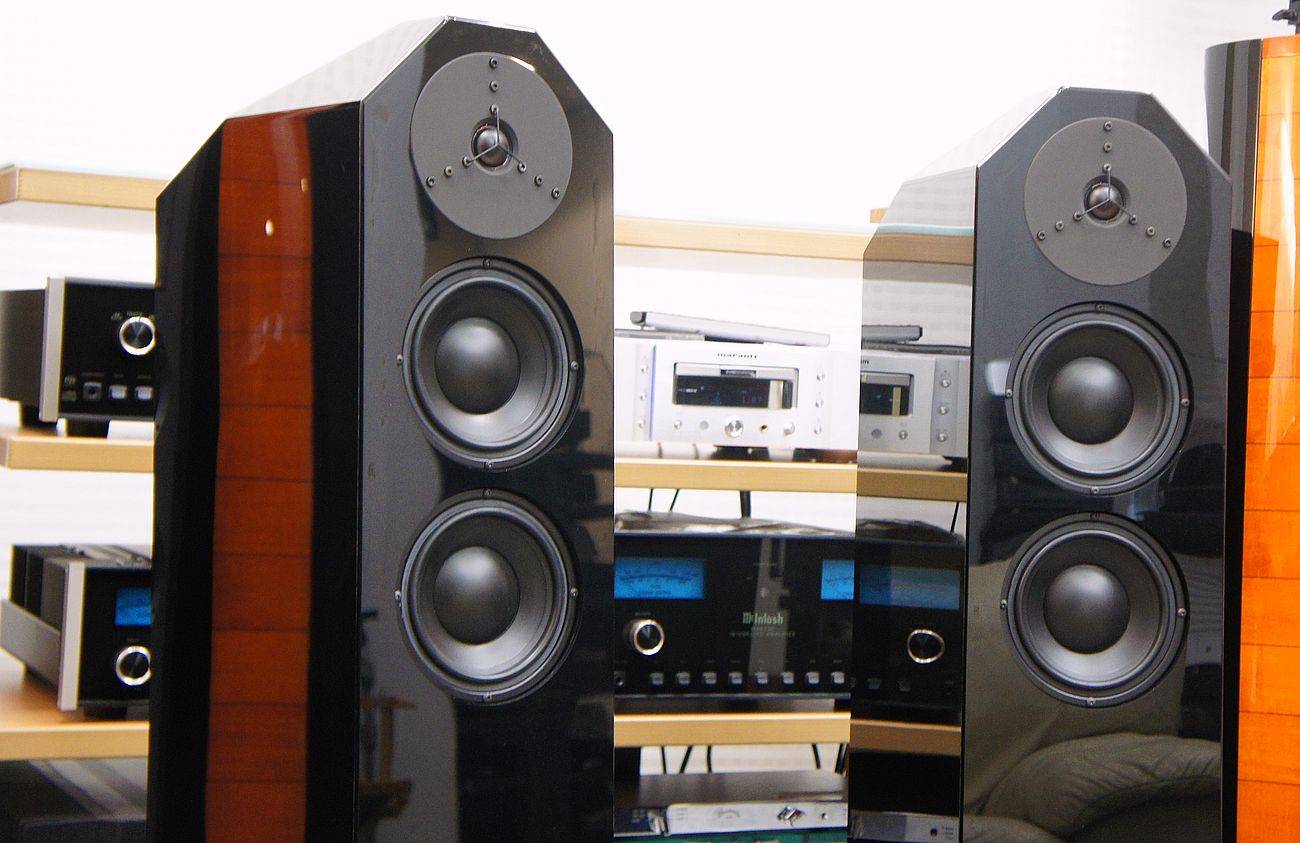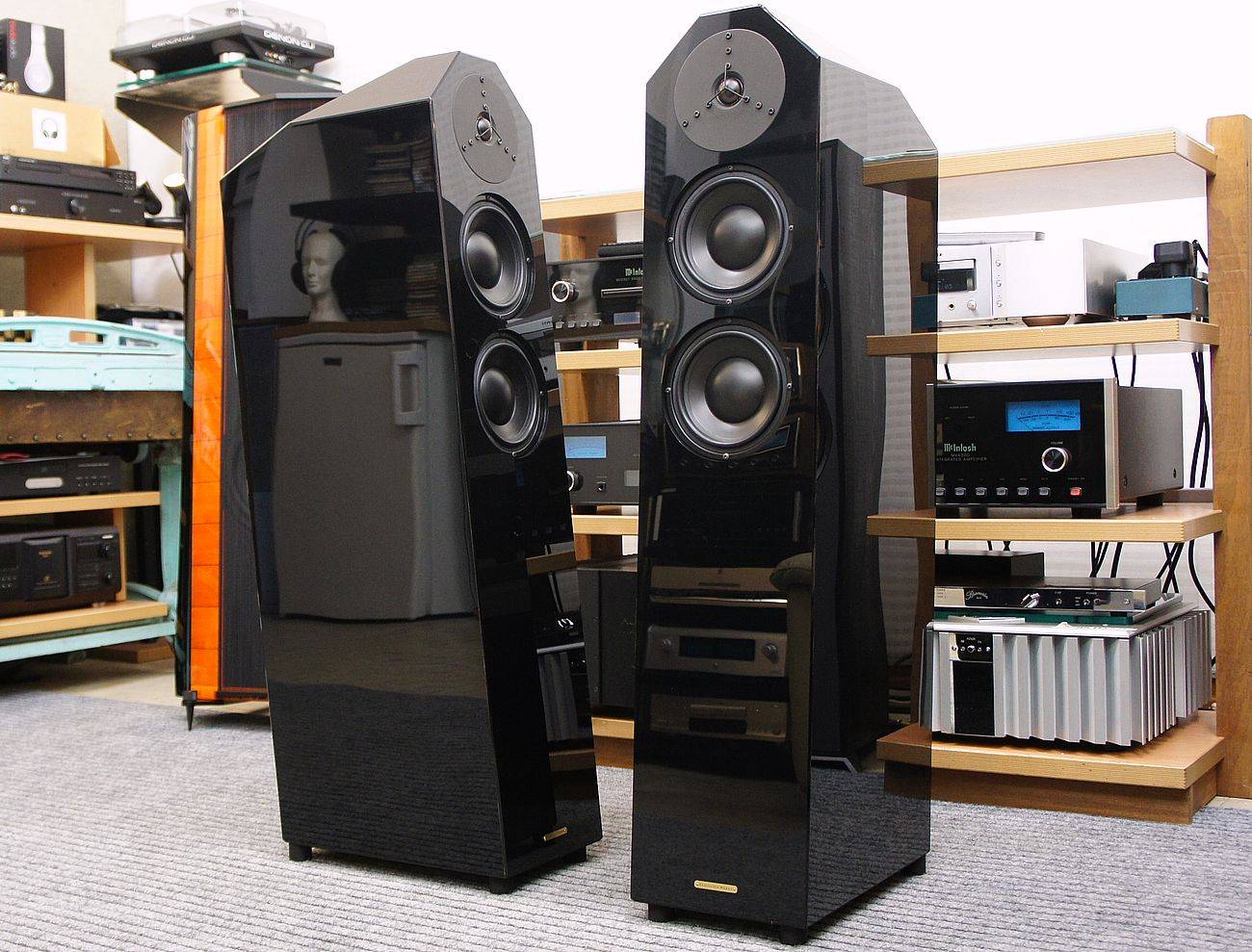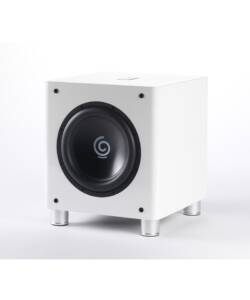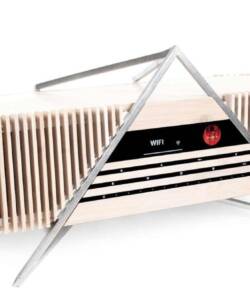EgglestonWorks Fontaine II Speakers (Crazy Bargain)
Original price was: R128,000.00.R25,000.00Current price is: R25,000.00.
EgglestonWorks Fontaine Signature Loudspeakers
- Written by Tim Shea
 Way back when, I was a teenager looking to buy my first set of “serious” speakers with the hard-earned money I made on my paper route, and went looking for the biggest suckers I could find per dollar spent. Sound quality was a consideration, but I’m embarrassed to say that looks and woofer size were at least as important as the quality of sound the speakers could produce. I ended up with a pair of Pioneer HPM100s. I still have them today . . . though I can’t remember the last time a signal passed through them.
Way back when, I was a teenager looking to buy my first set of “serious” speakers with the hard-earned money I made on my paper route, and went looking for the biggest suckers I could find per dollar spent. Sound quality was a consideration, but I’m embarrassed to say that looks and woofer size were at least as important as the quality of sound the speakers could produce. I ended up with a pair of Pioneer HPM100s. I still have them today . . . though I can’t remember the last time a signal passed through them.
Since those blissfully ignorant wonder years, more time has passed than I like to admit. Fortunately, I’ve actually learned some things since then. Of the few I can remember, one is that it’s often not the size of the package that counts, and that’s certainly true of speakers. It took me a while to accept this, but accept it I have, to the point where my next pair of speakers may be minimonitors. Never woulda seen that coming not so long ago.
So when the relatively smallish Fontaine Signatures arrived from EgglestonWorks, along with their not-small price tag of $8500 USD per pair, I wasn’t nearly as concerned as I’d have been back in the day. That said, knowing what else is out there at that price had me thinking that they’d better pack a bunch of sound per square inch.
Description and setup
The Fontaine Signatures were shipped in hefty boxes on pallets (in my experience, this is very rare with speakers this size), wrapped in cellophane, and, under the wrap, in soft cloth covers. I’ve found that the quality of packaging frequently reflects the amounts of care, quality, and overall thoughtfulness a company takes with the manufacture and shipping of its products. This was a good first impression.
As I wrested the speakers from their shipping coffins, it was obvious at first glance that the fit’n’finish of these middleweight contenders was top-notch. My review pair was painted in an attractive gray metallic paint that would not look out of place on a German luxury automobile — I see why EgglestonWorks didn’t skimp on the packaging. (I later learned that the paint used is actually a Porsche color modified to work on speakers.) Each speaker gets three coats of color and four of clear coat, and looks it. Also included were magnetically attached grilles (I never used them) and some hefty floor spikes. The fairly brief manual contains the necessary information, along with some helpful tips on placement (more on this later).
Each Fontaine Signature weighs 70 pounds (felt more like 90 to me) and measures 41″H x 8.5″W x 12″D. The top panel angles toward the back, to complement the interesting industrial look established by the front baffle’s large, silver, rectangular aluminum plate with rounded ends, under which the drivers sit. While I found the Fontaine’s overall shape appealing, I was less enamored of that silver plate, though I’m sure it’s there for a good reason. My wife didn’t take to the Fontaines’ looks, information she was happy to offer unsolicited (my mom concurred). Suffice it to say that the Fontaine’s look can be polarizing; it’s probably not for those who want a traditional look that will blend with fine furniture.
I’m more concerned with what’s inside and what comes out of a speaker. And while I’m sure the Fontaine’s paint job ain’t cheap either, a closer inspection began to reveal where Eggleston spent their money, and why they’re asking you to spend so much of yours. In designing the Fontaine Signature, which is based on the Fontaine II, Eggleston not only upgraded the drivers, but also upped the parts quality of the crossovers with Mundorf capacitors. When I received the Fontaines, they were still listed at $7900/pair; the price was raised to $8500 in large part due to the increased cost of its expensive drivers. At the top is a Dynaudio Esotar 1″ fabric-dome tweeter, which is crossed over at 3kHz, via a second-order slope, to the two 6″ carbon-fiber Morel midrange-woofers below it. Both midrange-woofers cover the same frequencies; this is strictly a two-way design.

All these costly bits are enclosed in a cabinet whose walls consist of two panels of 5/8″-thick MDF glued together, for a total thickness of 1.25″. Given how heavy these guys feel, that didn’t surprise me, but while the cabinet is fairly inert, it wasn’t the deadest I’ve rapped with a knuckle, that test producing more of a hollow thunk than the solid thud I expected. ’Round back is only one pair of solid binding posts — Eggleston maintains that, given the design of the crossover, adding a second pair of posts for biwiring doesn’t yield significant improvements in sound. Above the binding posts are two small ports, one above the other. An interesting design element is that, inside the speaker, there’s a shelf between the two ports, with a third, vertical port in the shelf itself. This is said to help get the most out of those expensive midrange-woofers.
All of this results in a claimed frequency response of 38Hz-24kHz, -3dB, a sensitivity of 88dB, and a minimum impedance of 5.6 ohms (8 ohms nominal). EgglestonWorks recommends a minimum amplification of 50W, but in the real world they prefer 80W to get the job done. My reference amp puts out a conservative 100Wpc; I never had a problem driving the Fontaines, even at fairly ridiculous listening levels. I didn’t have to turn the volume knob any farther than usual, and since my Soliloquy 6.2 reference speakers aren’t a heavy load, I’d say the Fontaine Signatures are pretty user-friendly in this regard. Still, low-powered tube amps need not apply.
In perusing the EgglestonWorks website, I couldn’t help noticing how similar the Fontaine Signature looks to the top section of one of its stablemates, the lauded Andra III ($23,500/pair); I wondered if they were similar inside as well. When I asked the company about this, they said I was basically correct in terms of the parts used, although, given the Andra’s additional bass drivers and larger cabinet volume, they tweak the crossovers a little differently. In fact, the drivers used in the Fontaine are the same as those in their second-from-the-top model, the Savoy Signature. I like when companies trickle down their best work to lesser models. The cheapskate in me wondered if pairing a couple of good-quality subwoofers with the Fontaine Signatures could get me close to the Andra IIIs’ performance, but at a nice discount. Hmm.
The manual says that the Fontaine Signatures are designed to be set up closer to the front walls than are many speakers, and farther apart to increase soundstage width. I found this to be the case; the review samples ended up about 1’ farther back and 1’ farther apart than I usually place speakers in my room. Pushing the speakers still farther back yielded deeper, more impactful bass without overdoing it, but began to compromise elements of soundstage depth that weren’t worth it to me. Overall, I found the Fontaine Signatures unfussy about positioning in my room, and while they appreciated being nudged an inch or so in the right direction here and there, their sound never collapsed or was significantly compromised, no matter where I put them.

Signature sound
Right out of the box, the Fontaine Signatures sounded very good, and better than many fresh-off-the-line speakers I hear. EgglestonWorks says in the manual that they do some running-in at the factory (this doesn’t exceed 100 hours), and I have to think that had a lot to do with what I heard. That’s not to say there was no benefit to further run-in, which mainly involved a tightening and better integration of bass frequencies and increased midrange transparency. The company says that the speakers will start to hit their stride after some 200 hours of run-in; however, not knowing exactly how long they’d been run in at the factory, I gave them another +200 hours of quality playing time before sitting down to do any serious listening.
The first thing that hit me about the Fontaine Signature was that it was very even-keeled — no part of the frequency range stood out, or sounded out of whack or wrong in any way. Right after that, I noticed that the midrange was very resolved, but with lots of expressiveness, which sometimes come at odds with each other, in my experience. Another obvious strength was the bass, which was extremely tight and tuneful, and fast. In fact, within its limits, and as a whole, I’ve not experienced better bass in my room — a stark reminder that it’s not the size of the package that counts.
Those were my first impressions. The real test would be how the speakers played music as a whole. Short answer? The Fontaine Signatures conveyed music as, well, music. Listening through them, I went beyond dissecting the music and focused more on its meaning — the playing styles and little inflections that make it sound real. I’ve heard some impressive and expensive speakers that can slice and dice a soundstage into the finest gradations with otherworldly pinpoint accuracy, but I end up noticing that more than the music that’s supposed to be emerging from that impressive soundstage. Such products are audiophile speakers for audiophiles, and they have their place. On the other end of the spectrum are those overly romantic or “forgiving” speakers that can make cut-glass recordings sound like the musical equivalent of a feather pillow. Although such speakers are easy and fun to listen to, such ease usually comes at the expense of hearing those subtleties that clue you into the recording space, or the microdetails that convey meaningful information such as individual playing techniques or transient snap. I mention all this because, more than any other speaker I’ve had in my room, the Fontaine Signature could equally please the audiophile, the musician, and the music aficionado. This speaker is the proverbial long, straight shot down the middle of the audio fairway.
I pulled out electric bassist Dean Peer’s Think . . . It’s All Good (CD, Turtle), which I hadn’t played in a while, but remembered had lots of articulate twists and turns that would put the EggWorks speakers through their paces. The bass guitar in “Air Circus No.1” sounded particularly accurate and real. In fact, everything sounded quick and tight, with tons of detail — not to the extent of being thrown at me, but extreme detail in service to the music and the musicians. “It’s All Good” backed this up, the Fontaine Signatures portraying a nice sense of space and the instruments within it. Instruments that were clearly at the back of the stage were there, but not far back, and not so diminished in size and tonality that they were on the other side of my front wall, somewhere in my neighbor’s house. Most impressive were the nuances of the performance that clearly came through — the phrasings, minute plucks, and subtle volume shifts that make live music so interesting and involving were there in spades: resolution in the service of the music rather than resolution for resolution’s sake. Very nice.
One disc I’ve had mixed success with in my system is Eva Cassidy’s Live at Blues Alley (CD, Blix Street 10046). It’s a live recording; with a highly resolving system you can really get a sense of Blues Alley in your listening room, but I’ve also heard her sibilants overemphasized to the point of distraction. It’s a fine line — systems through which Cassidy’s voice sounds full and balanced tend to gloss over the microdetails that convey the sense of space that’s recorded on this disc, which takes away from the full enjoyment of this experience. The Fontaine Signatures dug into the guts of this recording, re-creating the event in a perfectly balanced and believable way. Cassidy’s voice was tonally complete and wholly present in the room, without the etch I’ve heard other transducers produce, and the essence of Blues Alley’s acoustic was fully conveyed. It was like having a table at that evening’s concert. Between hearing the instruments on the Peer CD and the quality of reproduction of Cassidy’s voice, I found the tonality and resolution of the Fontaine’s midrange exemplary.
From the word go, the Fontaine Signatures’ Esotar tweeters sounded fabulous, and continued to impress throughout my listening. They produced the cleanest, purest, most articulate and tonally authentic highs I’ve heard in my room. The trick is that, as good as the highs were, they didn’t stand out on their own, but rather blended in, meshing with what was being produced by those Morel drivers. I’d had my doubts in this area. I’ve heard other speakers with dual midrange-woofers producing the same frequencies, and often the result was an overemphasis of the upper bass and lower midrange at the expense of balance, neutrality, and transparency. Not here. EgglestonWorks has fully and naturally integrated the Esotar tweeter’s output into the musical whole, as it has the mids and the upper bass. Credit here must go to the careful execution of the crossover; despite using drivers made by different manufacturers, the Fontaine Signature sang with a single, natural, very complete voice.
At the other end of the audioband, and as noted earlier, the bass was impressive. It wasn’t the huge bass sound of monster tower speakers; rather, what I heard was generous, but commensurate with what you’d expect from a cabinet and drivers of this size and quality. What impressed me was that the Fontaine Signature’s entire bass range was extremely tight, fast, and tuneful, to the point that I could follow pitch changes in things like low-end bass-guitar runs that other speakers gloss over or mush together. The descriptors that kept coming to mind were articulate, tight, tuneful. And very much so.
Any shortcomings? Not many, and those are more matters of degree, based on physics or personal taste. I find this speaker hard to fault. But as good as its bass was, it didn’t pack the gut-pounding punch you get with a large floorstander and/or subwoofer. I still got a good dose of what was there on the recording, but at this price, there are plenty of other speakers that outdo the Fontaine Signature on that score. And while the Fontaine Signatures soundstaged very well indeed, they didn’t go to the extreme of what some would call audiophile trickery. Rather, it was a more natural portrayal of how you’d perceive a layered soundstage at a concert. I think most people would find this a good thing, but I can also see those who like that kind of überdimensional, wall-defying, carved-with-a-scalpel imaging wanting just a little bit more. And there’s that polarizing looks thing. As I said: personal taste.
Comparisons
I perused the past few years’ worth of the SoundStage! Network Buying Guide and culled the award winners in and around the EgglestonWorks Fontaine Signature’s price range. In order of ascending price per pair, its direct competitors include: Paradigm Reference Signature S6 v.3 ($5798), Anthony Gallo Acoustics Nucleus Reference 3.5 ($6000), MartinLogan Ethos ($6495), Focus Audio Prestige ($6800), Dynaudio Focus 360 ($7000), Thiel Audio CS2.4SE ($8000), MartinLogan Spire ($8495), and Focus Audio Prestige FP90 ($9495). And nipping at its heels from the minimonitor segment are such impressive characters as the Joseph Audio Pulsar ($7000) and Dynaudio C1 Signature ($8500), to name two off the top of my head. In short: At these prices, you’d better deliver.
What I do know is that, for years now, my trusty Soliloquy 6.2s ($2699/pair when available) have remained at my side while facing some serious competition. And while they’re by no means the best speakers I’ve had in my room, and were quite a bit cheaper than the EggWorks, I know the strengths and weaknesses of my references well enough to use them to ferret out the qualitative differences among much more expensive models.
Despite being a good bit larger than the Fontaine Signatures, my Soliloquy 6.2s sounded like the smaller speakers in most regards. The 6.2s’ sound is more of the airy/spacey variety, and so they do a little better job of making the walls of my room “disappear” — but they also sound quite a bit thinner and brighter overall. The 6.2s come across as very detailed, the EggWorks as more highly resolving. Through the Fontaine Signatures, instruments had more of that “lit from within” quality that makes them sound more real, convincing, and complete. The 6.2s had a little more punch on the bottom, but the Fontaines were significantly tighter, faster, and tonally more articulate from there on up. A strength of the 6.2s is their ability to “disappear” as a sound source, especially for a decent-sized floorstander, and the EggWorks matched them in this regard. On the whole, the two models produced two very different sounds; the Soliloquys seemed a bit out of their league.
The Fontaine Signatures were more reminiscent of the very good Selah Audio Verita monitors ($2650/pair), which I reviewed in January 2011. It’s been a while since they were here, and due to some storm damage my room has changed a bit since then, so admittedly this comparison is a bit of a stretch. However, from what I recall, the Selah had the same sort of refined sound as the Fontaine Signature, with similarly impressive tonal characteristics, though I remember the Selah having a little more punch and heft down low, despite being stand-mounted. I give bass articulation and speed to the EgglestonWorks, and though both models have very nice, clean highs, the Selah’s ribbon tweeter sounded a little sweeter and more laid-back, the EggWork’s Esotar tweeter more tactile, detailed, and dynamic. The midrange of both speakers was excellent; to say more, I’d have to hear them side by side again.
Conclusions
If you’ve read this entire review, you know that I’ve given the EgglestonWorks Fontaine Signature the “best I’ve heard in my room” accolade in a few different areas. I’d also have to say that, overall, this is the most well-rounded and accomplished speaker I’ve heard here. Were it not for my desire to hear some of the other contenders at or near this price, I’d consider adding the pair of them to my arsenal, probably with a couple good subwoofers, in an attempt to create my own pair of mini-Andra IIIs. But even without the benefit of subs, there’s enough greatness happening from the Fontaine Signature’s bottom up to render subs optional. I’ve heard excellent speakers that would please any obsessive-compulsive audiophile, and others that make such beautiful music that they can bring grown men to tears. The EgglestonWorks Fontaine Signature is that rarity among loudspeakers: It does both, and without dominating your room while doing so. Growing up does have its advantages.
. . . Tim Shea
[email protected]
Associated Equipment
- Speakers — Soliloquy 6.2, Selah Audio Verita
- Amplifier — McCormack DNA 0.5 Rev.A
- Preamplifier — Bryston BP 6 C-Series
- Digital sources — Oppo DV-970HD universal A/V player (used as transport), Electronic Visionary Systems Millennium DAC 1 D/A converter
- Interconnects — Acoustic Zen Silver Reference II, Stereovox Colibri-R
- Speaker cables — Acoustic Zen Satori
- Digital cables — Stereovox XV2 coaxial, Apogee Wyde-Eye
EgglestonWorks Fontaine Signature Loudspeakers
Price: $8500 USD per pair.
|
[May 12, 2002]
davidhowells
AudioPhile
STRENGTH:soundstage is massive. bass very low and detailed. naturally neutral
WEAKNESS:they are a black hole for inferior amps and front end.
i was looking for a decent pair of speakers to accompany my newly aquired tube technology synergy integrated amp.i demoed the proac range of speakers up to$5k.their vocal repro was outstanding but i felt they had little else.i demoed the eggs with mark levinson cd,pre & monoblocks with a friend who i just happened to bump into that day.he”s not an audio nut but his first words were it”s like we”re there.i was sold.like all high class speakers they are power hungry and are extremley critical of front end. so make sure you have good amps and cd before you try them or you will be upgrading everything. Similar Products Used: naim,proac,spendor |
|
[Nov 29, 1999]
Ross Penney
Audio Enthusiast
STRENGTH:Emotional impact of music,extraordinarily musically communicative, wonderful mid range,does not favour any one type of music, work brilliantly with mid-level components
WEAKNESS:Care required with system matching to avoid overbright treble from Dynaudio Esotar tweeters, largeish room necessary, that’s all
The Fontaines are my first high-end speakers (I had used and enjoyed Epos ES11s for years). I had no intention of buying anything so expensive, but five minutes with my system (Primare 30.2 CD player, Electrocompaniet EC1-2 amplifier, Linn LP12/Ittok/Karma, Lehmann Audio Black Cube, Kimber cabling and powerblocks) was enough – there was something really special going on here. When the speakers were delivered I invited some friends round. One brought the Rattle CBSO Mahler Resurrection and played the finale at somewhat more than concert hall volume. Not cheap, but able to work brilliantly with the Electro amp (an audiophile bargain if ever there was one), the Fontaines do all the traditional “hi-fi” things but at the same time make them irrelevant as they deliver music, of whatever nature, in an emotionally engaging and informative way. A first rate product, very highly recommended. Similar Products Used: None |
|
[Jan 30, 1999]
Simon
an Audiophile
Although it sounds expensive to buy a pair of 5k speakers which is not a floor standing model (like Wilson’s watts), this pair has one of the most accurate mid-range and highs I’ve ever heard (much better than my previous Thiel 2.3 which sounds overly bright). Bass is very dependent on filling adequate sand in the large base; and although it does not go as low as the Thiel, it sounds very fast and tight indeed. |
|
[May 15, 2000]
NKT
Audio Enthusiast
STRENGTH:very musical, refined, no box colorations
WEAKNESS:none
These standmount speakers may seem expensive at a retail of $5,400 but they are truly one of the most musical speakers I have ever heard. One word comes immediately to mind when describing these speakers: refined. They have a sense of class and sophistication way beyond that of b&w and dunlavys. Revel Salon and Studio will give a greater soundstage and better bass albeit at a more expensive price, but nevertheless the Eggys sound sweeter than the Revels. Similar Products Used: revel salon, studio, dunlavy sc4, b&w nautilus 801 |
|
[Jun 13, 2000]
Ham
STRENGTH:soundstage size, low-capabilities, beautiful mids and highs, appealing looks that please my wife.
WEAKNESS:none
The Fontaine has got to be the best speaker going at its price point and definitely one best I ever heard at any price. I was ready to spend much more money at local dealer when a freind said to listen to the Fontaine first. Luckily, I could listen to it easily since the dealer carried both brands. From the end of the first track i knew this was special speaker. The fullness of the music is like no other monitor speaker i audition. I will advise filling the stand with sand as others here have said. Sand enhances the bass to a level that is unheard of in speaker this class. I have tried to tell everyone i meet that the Fontaine is the best speaker I know – but make decision for yourself. After very short time there will be no question. The Fontaine is one of the best speakers on the market today! Similar Products Used: b&w 802, revel salon, wilson watt/puppy5 |
Here is a review of the OLD model 1
| EgglestonWorks Fontaine Speaker |
| Henry Wilkenson |
| 15 November 2001 |
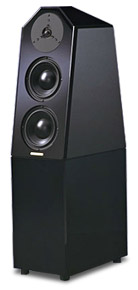 Specifications
Specifications
Frequency Response: –3db @55 Hz to well beyond 24,000 Hz
Efficiency: 87 db.
Impedance: 8 Ohms, nominal, Minimum impedance: 6.3 Ohms.
Tweeter: One 1″ cloth dome with large diameter vented pole piece.
Mid-bass, bass: Two 6″ polypropylene double magnet drivers with 3″ voice coils.
Single Rhodium binding posts
Dimensions: 9 ½” W. X 151/2″ D. X 17″ H.
Weight: 70lbs each
Website: www.egglestonworks.com
EgglestonWorks is a company that I had heard of long before I ever had the chance to sample their wares. Located in Memphis, Tennessee, EgglestonWorks was founded in 1992 with the goal of producing the finest loudspeakers possible and is applied to all of the products in their line. Their first offering was a speaker that looked like an end table but ultimately was not as successful as they had hoped. In late 1996, the Andra was released. While it received wide acclaim and generated strong sales, EgglestonWorks continued to modify and refine the speaker.
The opportunity for me to hear an EgglestonWorks speaker came by way of my friend and colleague, Marshall Nack. Some of you long term readers may recall Marshall’s in-depth review of the EgglestonWorks Rosas. I have had many an opportunity to listen to those speakers since they have taken up residence as Marshall’s reference speakers.
Marshall, and his lovely wife Lynn, are an unusual couple in that they are both audiophiles. Actually, they are the only audiophile couple that I am personally acquainted with. I’m sure the fact that they are both serious musicians is largely responsible for their being able to hear very fine tonal gradations and detail with such ease. Among his many talents, Marshall has an exceptional ability to voice a system. He always seems to be able to find the right mixture of components and accessories that result in an exceptionally well-balanced system. This is far more difficult to accomplish than you might think. However, the revealing nature of the EgglestonWorks speakers was instrumental in achieving his sonic goals. With each substitution of components or accessories, the Rosas clearly revealed the sonic contributions, for better or worse, of whatever hardware changes had been made.
When the Stereophile Show came to town this spring, the EgglestonWorks room was high on my must visit list. It was there that I met EgglestonWorks prez Jim Thomson, and took my first listen to the Fontaines. I know you have all heard that the sound quality at shows is generally pretty bad. While I find this to be largely true, at the same time, you can get some idea of a product’s sonic potential, or how it might ultimately perform under home conditions. The Fontaines were set up in Eggleston’s home theater room. Included with the display was a pair of dedicated sub-woofers. Though I’ve never ventured into the realm of home theater for a number of reasons, primarily a lack of space, I have to admit that this set-up sounded quite good.
According to company literature, “the design of each loudspeaker model in the EgglestonWorks line begins with the midrange.” For the Fontaines, a pair of 6″ polypropylene, double magnet drivers handle the midrange and bass. Each of these drivers has a 3″ diameter voice coil. It has been said many times before but it bears repeating, as it is so true; if the midrange is not correct, than all else is fruitless. The tweeter has a large aperiodic damping chamber that imitates infinite baffle loading. The tweeter is hard wired to the crossover with one cap and two resistors used as an L-pad.
A single set of binding posts is mounted in a recessed panel on the rear of the driver section. I asked Jim Thompson about using a single set of binding posts as opposed to the current trend of using dual posts. He told me that after extensive listening tests, and as the midrange has no crossover, it was decided that there were no sonic gains to be made by the addition of a second set. The drivers are directly connected to the binding posts. Of course, if a customer is set on biwiring, these speakers can be outfitted with dual binding posts by special order. If you wish to use what Perry has so aptly named “rigor mortis” cable, you will have to use banana plugs in order to reach the recessed binding posts without unduly stressing the cable.
The bass and mid-bass drivers are housed in what EgglestonWorks describes as a quasi transmission-line loaded enclosure. This is accomplished by employing a specialized acoustic stuffing material known as “acousta stuff.” This is a polyester strand that is crimped every millimeter. This makes every strand a complex shape, capable of providing greater diffraction to the sound waves traveling through it. The cabinet is constructed of 5/8″ thick MDF wood panels, twice laminated with an imported damping material. To further damp the enclosures, the outside panels have one-centimeter thick, Italian granite slabs bonded to them. The end result of these efforts is a very inert enclosure that provides much better bass response than the small size of the drivers would indicate.
After several conversations with Jim Thompson, four medium-sized but fairly heavy cartons arrived from EgglestonWorks. The cartons contained the driver and the matching base sections. You should be very careful while setting up these speakers so as not to damage the exquisite piano black finish. The picture does not in any way do justice to these speakers. You really have to see them in person to understand what I mean. The Fontaines can be viewed as one of those products that fall into the “audio as art” category. They are simply beautiful.
The fit and finish is right up there with the best that I have ever seen. It is obvious to me that EgglestonWorks has taken a great deal of care and gone to considerable expense in the design and construction of these enclosures.
Once assembled, the speakers give the appearance of a monolithic floor stander. The bases are sand-fallible and will form a very substantial enclosure. I would strongly advise you to settle on final placement before filling the bases with sand. These babies are quite heavy to begin with; once filled with sand, they would be almost impossible for the average person to move alone. I placed the speakers on a quilt, then on their sides, to insert the four bolts that hold the bases in place. This is done through an access panel in the bottom of the base. While the spikes that are supplied are very sturdy ones, they have a fine thread and can be easily damaged if you are careless while installing them. The driver enclosure is very inert so I would advise great care if you decide to perform the knuckle test.
I particularly like the way they have chosen to deal with the grills. They are constructed with a very sheer material mounted on a slender steel frame. They attach to the front baffle by means of magnets that are buried under the surface laminate. This arrangement makes attaching the grills as simple as possible and worked just fine for me. I found the grills to be audibly transparent, so I choose to leave them in place.
While the efficiency is listed as what might seem like a rather low 87db, I had no problem-achieving lease breaking levels with the Bel Canto EVo power amp. However, I would not recommend trying to drive the Fontaines with single ended triodes.
When I receive new equipment to review, I will often invite several non-audiophile friends over, fire up the system and observe their reactions. In each case, the reactions to the Fontaines began before the first CD was in the drawer and they were always quite positive. Everyone was taken with their striking appearance and the way that they so easily blended into the room. They are as beautiful as they are unobtrusive. While it is quite obvious from the specs and the quality of the hardware used that EgglestonWorks constructs its speakers with a great deal of care, the most important question is yet to be answered.
How Do They Sound?
After a suitable break-in period, I sat down to give the Fontaines a serious listen. The company states in its literature that the primary design tool used to voice the entire line of speakers is the sound of music as opposed to a primary reliance upon measurements. Since I do not have the ability to perform any measurements on the equipment that I have for review, I can only tell you how they perform in my system. While I believe that measurements do have their place, they hardly give the total picture. There have been many components that have measured terribly but were stellar performers sonically, and vice versa.
Even before the speakers were fully broken in they sounded quite good. I found two of the most prominent sonic attributes of these speakers to be their midrange clarity and their ability to paint a rich harmonic portrait. They have that see-through quality that allows each instrument to occupy its own space, but always with a natural sense of proportion within the soundstage. No hardness or edginess ever accompanied this clarity. I also noticed a consistent easy quality to the sound that just let the music flow in a most seductive way. Cymbals and bell tones have the proper amount of sheen and delicacy and again, they seem to have the right size. The decay rates for these instruments also contribute to the sense of realism.
The Fontaines floated a very good image across the stage with excellent localization of the instruments. They consistently revealed the low level details that among other things gave a real sense of the size of the recording venue. With Miles Davis, Kind of Blue, [Columbia CK52861 – Gold Version and Columbia CK64935 – 20 bit Re-master] by Miles Davis, Bill Evans’ piano comes across much more realistically than I usually hear it. I have always taken issue with the recorded sound of the piano, especially with many of the older Blue Note recordings. Just the opposite is the case with the XRCD recording, Waltz for Debby by the Bill Evans Trio [JVC XRCD VICJ-60141]. Here the tonal qualities and complex harmonic structure of the piano are presented very well.
I was surprised by the sense of depth that these speakers presented me with. My room will not cooperate very much in this area, so this was a welcomed surprise. In fact, it is the best that I have heard here. The center fill was spot on with soloists being a little more forward than I am used to but it was to good effect. Overall, I found the imaging abilities of these speakers to be exceptionally good. For my taste, they struck the right balance between image specificity and naturalness. The great deal of effort that EgglestonWorks has put into the design of the driver enclosures really pays off in the superior imaging qualities of these speakers.
Since the –3db point is listed at 55hz, I didn’t expect too much from the lower regions but I was pleasantly surprised with what I did hear. Now don’t misunderstand, these are not the speakers for pipe organ or reggae fans. For that kind of bass output you should look much higher up in the EgglestonWorks line. What is notable about the low end in this case is the accuracy of the bass. It is never boomy; rather, it tends to be tight and tuneful. When poorly executed, the bass can obscure musical elements in the lower midrange. The bass of the Fontaines does not interfere with or obscure the midrange at all. In other words, the bloom of the low end does not come at the expense of midrange clarity. For classical and a good deal of jazz, you could be quite satisfied with the low end of the Fontaines. Overall, the bass output was much better than I expected.
Tim Shea wrote a terrific review of the Musse Audio Reference Two NF speakers last June. I have them on hand and will do a follow up review. However, since they are in the same price range as the Fontaines, I thought they would make an interesting comparison.
The Reference Twos, like the Fontaines, are two-way monitors. In this case, you supply the stands. The sonic differences are striking because of the strengths of each lie at opposite ends of the sonic spectrum. With a -3db point of 35Hz and the port tuning frequency of 29Hz, it is not surprising that the Reference Twos go deeper. The low end here is tight and tuneful as well. While the Fontaines do not go as deep, I have to say that the bass is a bit tighter and a bit more tuneful than the Reference Twos. However, the Fontaines definitely get the nod for their midrange and upper register extension, sweetness and excellent rendition of detail. These are sonic traits that are a permanent fixture in Perry’s listening room and I have subsequently come to listen for them all of the time. In addition to this, there is plenty of air around the instruments with very good decay rates. Some might describe these speakers as being tonally neutral, however you wish to describe that characteristic. I, on the other hand, find their tonality to be slightly on the warm side. That suits me just fine. Overall they simply get out of the way of the music. This is what many speaker manufactures claim that their products do but the reality is often quite different.
Etta James, Life, Love and The Blues [Private Label 01005-82162-2]: This is a CD that is a very good example of the “Mussel Shoals” sound. It has a very heavy sustained bass line throughout many of the cuts. Check out “Here I am Baby” to see what I mean. In this instance, a good bit of this bass is attenuated. After all, you can only move so much air with a six-inch driver. The roll off is very graceful, with no sign of driver overload or other distress. From the upper bass on up all is well. Etta James’ voice comes through with the right amount of bite and warmth.
Patricia Barber, Companion [Blue Note/Premonition 7243 5 22963 2 3]: This is a live recording that really shines on the Fontaines. The sense of immediacy and presence is such that you can get an implication of the size of the room without any hyper-detail to get in the way. On the cut “Use Me,” there is an upright bass solo that the Fontaines reproduce with all of the textures and harmonic richness in tact. Ms. Barber’s voice has a breathy texture that is quite pleasant without the vocal detail ever being overdone. I never had the impression that I could see her tonsils.
With large-scale symphonic works, these babies continue in the same vein. While their limited low-end capabilities will diminish some of the slam and weight that their larger brethren are able to handle, they still give a satisfying performance.
To sum up, the EgglestonWorks Fontaines can best be described as being very musical. While they will give you all of the attributes that audiophiles crave, they are never overly analytical. I really appreciate the midrange qualities that keep my listening sessions on the long side. They make me want to get the audiophile stuff out of the way and just sit back and enjoy the music. I find myself pulling out CD after CD that I have not heard in a while to give a listen. If you feel that you simply must have that last bit of bass output, remember that matching subs are available. The characteristics of these speakers that impress me the most are the grainless midrange, top-end extension, the ability to float a realistic, totally coherent soundstage and the top-to-bottom ease of the musical presentation. I never heard any discontinuity between the bass, mids or the highs. They were always coherent in this regard.
These are very high quality speakers and you need to connect them to equally high quality gear upstream. Of course they will work with inexpensive amplifiers, but they will quickly reveal all of the sonic deficiencies and warts. The EgglestonWorks Fontaines are what the high end is all about. While they cannot be considered cheap and are in a crowded field at this price point, they do offer very good value considering their excellent performance.
Description
Specifications
Frequency Response: –3db @55 Hz to well beyond 24,000 Hz
Efficiency: 87 db.
Impedance: 8 Ohms, nominal, Minimum impedance: 6.3 Ohms.
Tweeter: One 1″ cloth dome with large diameter vented pole piece.
Mid-bass, bass: Two 6″ polypropylene double magnet drivers with 3″ voice coils.
Single Rhodium binding posts
Dimensions: 9 ½” W. X 151/2″ D. X 17″ H.
Weight: 70lbs each
